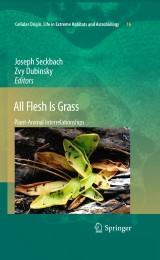Details

All Flesh Is Grass
Plant-Animal InterrelationshipsCellular Origin, Life in Extreme Habitats and Astrobiology, Band 16
|
213,99 € |
|
| Verlag: | Springer |
| Format: | |
| Veröffentl.: | 11.10.2010 |
| ISBN/EAN: | 9789048193165 |
| Sprache: | englisch |
| Anzahl Seiten: | 532 |
Dieses eBook enthält ein Wasserzeichen.
Beschreibungen
This new book takes us through a journey from early life to modern agriculture. The thirty eight authors present current studies on the interrelation of plants-animals. This topic has always fascinated man, as evidenced even by the first chapters of Genesis. The world of aqueous and terrestrial fauna appeared on early earth only after the flora covered the areas with the green pigmentation. Almost all life depends upon sunlight via the photosynthesis of the botanical world. We read abut the harnessing of bee pollination of crops to make it an essential component of modern agriculture endeavor. Some plants seduce insects for pollination by their appearance (e.g., disguised orchids entice visitors); there is the production of sweet nectar as a bribe in flowers to attract bees, butterflies, and honey-sucking birds. A particular outstanding phenomena are the carnivorous plants that have developed trapping and digesting systems of insects and higher animals.
Introduction . [Seckbach, J.].- List of authors and their addresses.- PART 1: EVOLUTION .- Evolution of Plant-Animal Interactions. [Chela-Flores, J., et al.].- PART 2: INSECTS INTERACTIONS.- The Leaf Cutting Ant-Plant Interaction from a Microbial Ecology Perspective. [Abril A.].- Intestinal Spirochetes of Termites. [König, H. and Dröge, S.].- The Plant–Aphid Universe. [Iluz, D.].- Insect—Plant Interactions: The Gall Factor. [Raman, A.] .- PART 3: POLLINATION AND SEED DISPERSAL.- Ants as Pollinators of Plants and the Role of Floral Scents. [Rostas, M. and Tautz, J.].- Crop Pollination In Modern Agriculture.[Dag, A.].- Bee Cognition and Crop Pollination: Proven and Potential Applications. [Shafir, S.].- Zoochory – seed dispersal. [Iluz, D.].- PART 4: ANIMALS AND HUMANS INVOLVEMENT.- Grazing Livestock, Our Connection To Grass: A Mediterra-Nean Insight: Why They Eat What They Eat, And How It Affects Us. [Landau, S.Y. and Molle, G.].- Herbivore – Plant Interactions And Desertification In Arid Lands. [Whitford, W.G. and Steinberger, Y.].- Microscopic in Size: Macroscopic in Impact. Diatom-Human Interactions. [Kociolek, J. P.].- PART 5: PLANT DEFENSES.- Biochemical Plant Defenses Against Herbivores: From Poisons to Spices. [Smith, C. M.].- The Xanthium Genus: Cocklebur Toxins Against Hostile Surroundings and Its Pharmacological Properties. [Seckbach, J].- PART 6: MARINE ENVIRONMENTS.- The Diversity of Epizoic Diatoms: Relationships Between Diatoms and Marine Invertebrates. [Totti, et al.].- Epizoic Diatoms on Gastropod Shells: When Substrate Complexity Selects for Microcommunity Complexity. [D’alelio, D. et al].- Managing the Interactions Between Plants and Animals in Marine Multi-Trophic Aquaculture: Integrated Shrimp and Valuable Low Food Chain Organisms with Seaweeds. [Robledo, D. and Freile-Pelegrin, Y.].- Marine Microralgae/Cyanobacteria–Invertebrate Symbiosis: Trading Energy for Strategic Material. [Stambler, N.].- The Role of Rhodolith Beds in theRecruitment of Invertebrate Species: from the South-western Gulf of California, Mexico. Riosmena-Rodriguez, R. and Medina-Lopez M.A.].- Fueled by symbiosis foraminifera have evolved to be giant complex protists.[Lee, J. J.].- PART 7: CARNIVOROUS PLANTS.- Ecophysiological Look at Plant Carnivory: Why are Plants Carnivorous? [Adamec L.].- Reversing the Roles of Predator and Prey: A Review of Carnivory in the Botanical World. [Rice, B.A.].- PART 8: OUTLOOK AND SUMMARY.- Summary, Final Comments and Conclusions. [Dubinsky, Z. and Seckbach, J.].- Organism Index.- Subject Index.- Author Index.
This new book takes us through a journey from early life to modern agriculture. The thirty eight authors present current studies on the interrelation of plants-animals. This topic has always fascinated man, as evidenced even by the first chapters of Genesis. The world of aqueous and terrestrial fauna appeared on early earth only after the flora covered the areas with the green pigmentation. Almost all life depends upon sunlight via the photosynthesis of the botanical world. We read abut the harnessing of bee pollination of crops to make it an essential component of modern agriculture endeavor. Some plants seduce insects for pollination by their appearance (e.g., disguised orchids entice visitors); there is the production of sweet nectar as a bribe in flowers to attract bees, butterflies, and honey-sucking birds. A particular outstanding phenomena are the carnivorous plants that have developed trapping and digesting systems of insects and higher animals.
Covering as diverse ecosystems as the sea, deserts and agroecosystems Includes micro to ecosystem levels Addresses evolutionary aspects of animal-plant relationships Integrates biochemical through behavioural relationships
Diese Produkte könnten Sie auch interessieren:

Agricultural Biodiversity and Biotechnology in Economic Development

von: Joseph Cooper, Leslie Lipper, David Zilberman

213,99 €

Policy Reforms and Agriculture Development in Central Asia

von: Sandjar Djalalov, Suresh Chandra Babu

213,99 €

Regulating Agricultural Biotechnology

von: Richard E. Just, Julian M. Alston, David Zilberman

213,99 €













